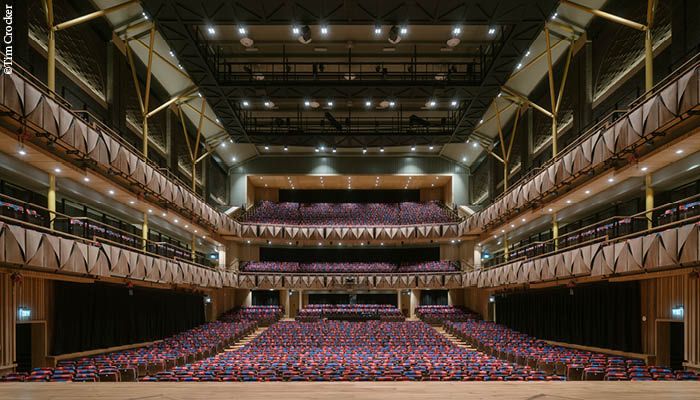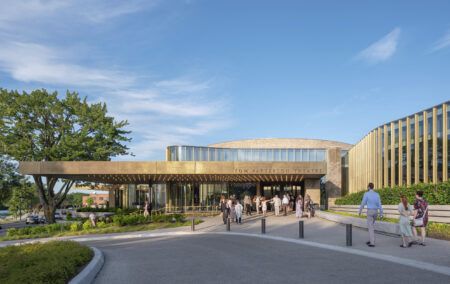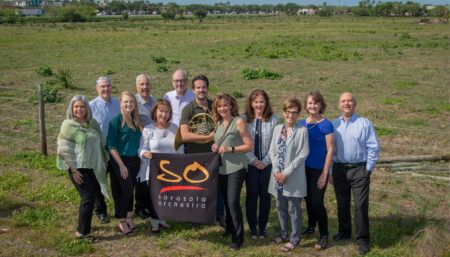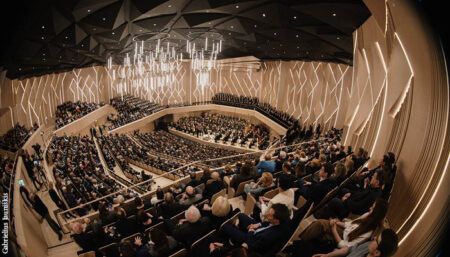Architecture studio Levitt Bernstein has completed the reimagining of the UK’s Bristol Beacon for Bristol City Council and Bristol Music Trust. This project has created a centre for the creation, performance, recording and broadcast of music, all under one roof.
This completion follows Levitt Bernstein’s new foyer building in 2009 – it is the second and final phase of the project. Levitt Bernstein has repaired, restored and upgraded the original fabric of the Grade II listed building, conserving the distinctive Victorian architecture while reimagining its future. The architectural works celebrate the Bristol Byzantine style of the original building while adapting it for today’s audiences and modern venue operation.
The project’s programmatic needs were extensive, including the renewal of existing music performance halls and backstage areas; the remodelling of secondary spaces, such as the underused cellars, to introduce new music education studios and a club-style third venue; and the insertion of new AV, stage engineering and upgraded building services. Additionally, a new restaurant has been incorporated within the historic colonnade.
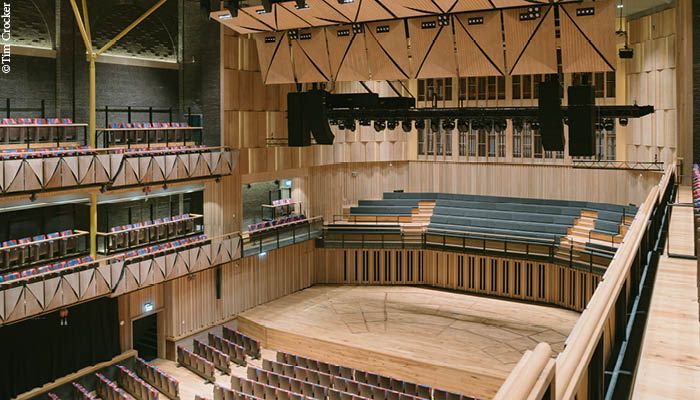
Bristol Beacon encompasses three main performance halls. Beacon Hall is a professional concert hall with capacity for around 1,800 (2,200 with stalls standing). Designed as a contemporary intervention, Levitt Bernstein has built a new flexible and adaptable interior within the 1867 original masonry walls. There are new timber-lined balconies, shaped to optimise room acoustics, with trifurcating steel columns to support the upper balconies and technical decks. The new interior has been nested into the building’s Victorian shell. Adaptability has been catered for with variable acoustics, removable seating and access for lighting.
The second, or Lantern Hall, has been much altered during the building’s history, having been converted to a theatre, bar, and ad hoc second venue since 2009. Levitt Bernstein has completed external restoration works that reinstate the original architectural composition of the Colston Street façade by removing later additions, reopening the colonnade to its original width of seven bays and reopening the windows to the Lantern Hall. At ground level, the former box-office space is now repurposed as a public restaurant and cocktail bar, which creates an activated ‘shop front’ with a new screen of frameless glazing positioned behind the stone columns. The full size of the original daylit atrium has been reinstated and features a new modern staircase contrasting with the Victorian architecture. The Lantern Hall sits alongside this space and is now a second performance venue for all kinds of music. With a smaller capacity of around 300 to 500 (standing), this space is designed for more intimate concerts, new work, spoken word and other events.
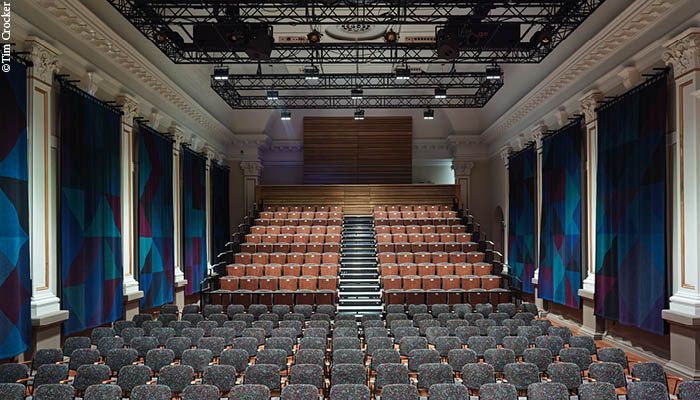
The former bonded cellars beneath Beacon Hall have been carefully converted into a suite of creative spaces for music education, practice rooms, a library, recording studio, digital music lab and a new cellar venue for smaller, more intimate concerts and emerging artists. This third hall is an additional performance space or cabaret-style club venue for 100-250 people that can also be used for rehearsal, education or as a break-out space.
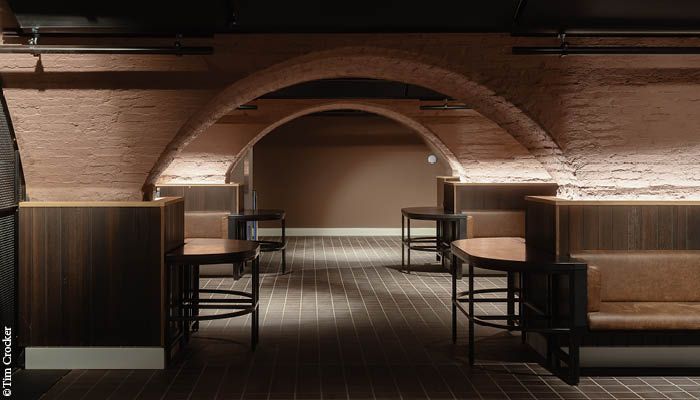
Public art curator Field Arts Projects worked closely with Levitt Bernstein to ensure Bristol Beacon is rejuvenated with artists’ voices at its heart. Linda Brothwell, Libita Sibungu, Rana Begum and Giles Round have each created a bespoke work to enhance the look and feel of the venue. Their work includes a response to the building’s relationship with the water that surrounds and flows through the city; the textiles and fabrics within the new performance spaces; an architectural installation within the new Lantern space; and a contemporary intervention on the façade of the Lantern building.
Two larger interventions and artworks, produced and curated by Bristol artist Cathy Mager, celebrate the rich social history and heritage of the Beacon building. Working with artist Mel Northover, the Story Wall created an intricate, illustrated narrative of the building’s history from its opening in 1867 to the present day, celebrating the unsung heroes and hidden stories of the venue’s past. For the new cellar space, neurodivergent artist Frankie Boyle has created Convergence; an undulating sculpture of ash wood ribs that resemble a warped keyframe inside a piano. This artwork is a homage to the music creation and innovation that has taken place in the building for more than 150 years.
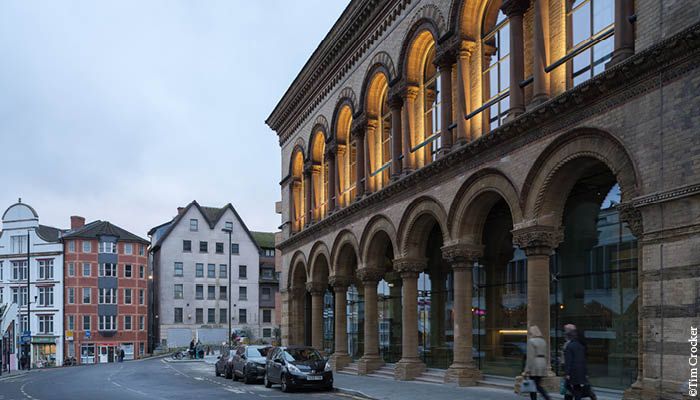
With a focus on acoustic excellence, sustainability and heritage, Bristol Beacon required a bold and imaginative strategy to ensure it would excel in use. The Beacon Hall is designed for the enjoyment of both amplified and non-amplified sound. Flexibility is designed into the acoustic strategy for high sound quality, to allow adaption for different uses and genres of music. Additionally, the transformation has delivered a reduction in sound transmission between halls and practically removed intrusion from external noise, Levitt Bernstein noted. To achieve this, the company collaborated with acoustician Sound Space Vision.
Levitt Bernstein prepared a masterplan for this phased project in 2001 and previously completed Phase One in 2009 with the addition of a new foyer building, recently renamed Bridgehouse. This building centres around an informal open performance space and provides access by lifts, stairs and bridges to the auditoria. It includes a café, interval bars, public facilities and flexible spaces that support the venue’s education, outreach and conference programmes.
Project team
Client: Bristol City Council for Bristol Music Trust
Architect and interior designer: Levitt Bernstein
Project manager: Mace/Arcadis
QS: AECOM
Main contractor: Wilmott Dixon
Acoustician: Sound Space Vision
Theatre consultant: Charcoalblue
Structural engineer and M&E: Arup
Heritage consultant: Alan Baxter


